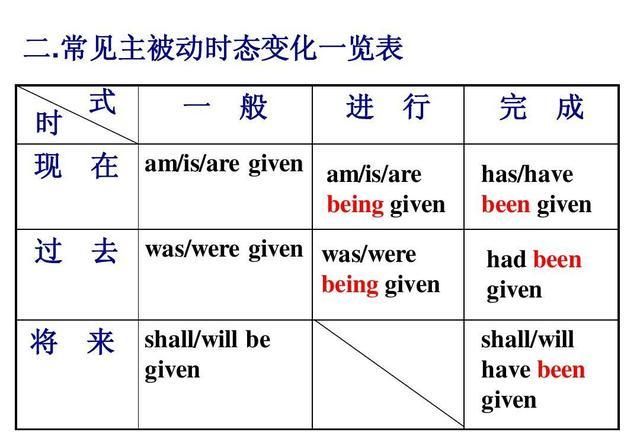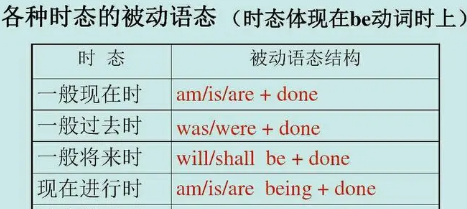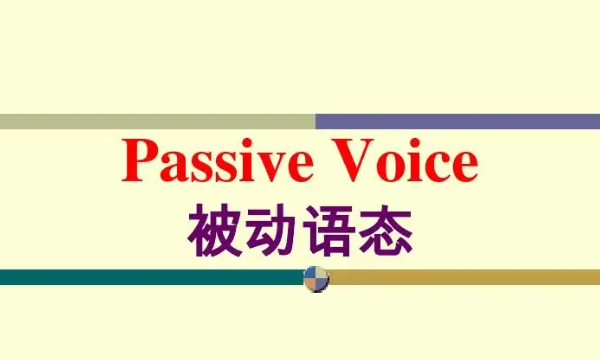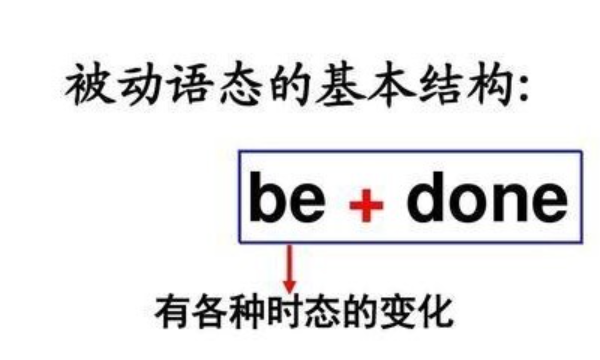本文目录
被动语态的各种形式表
英语中有两种语态:主动语态和被动语态。 语态是动词的一种形式,用来说明主语和谓语之间的关系。接下来,我给大家准备了被动语态的各种形式,欢迎大家参考与借鉴。
被动语态的各种形式
如果主语是动作的执行者,谓语用主动语态,如“We clean the room every day.”;如果主语是动作的承受者,或者说是动作的对象,谓语则是要用被动语态,如“The room is cleaned every day.”
被动语态的各种形式:
1) am/is/are +done
I’m asked to take care of myself.
Football is played all over the world.
2) has /have been done
This book has been translated into many foreign languages.
The prices of many goods have been cut again .
3) am/is /are being done
A road is being built around the mountain.
Many new houses are being built in this city.
4) was/were done
This house was built in 1958.
His leg was broken in an accident.
5) had been done
A new school had been set up by the end of last year.
When the anthem1 had been played the conference2 began.
6) was/were being done
The meeting was being held when I was there.
We were being trained this time last year.
7) shall/will be done
More factories will be built in our city.
He will be taken to hospital tomorrow.
8) shall/will have been done
The project will have been completed before July.
Your clothes shall have been made for you soon.
9) should/would be done
He told me that his new cloths would be made by his mother.
10) should/would have been done
He told me that his new clothes would have been made very soon.
扩展:常见的被动结构
1、SVO句型的被动结构
SVO句型中的谓语为单宾及物动词,其被动结构是:S + V(被动式) (+ by 短语 )。例如:
He wrote1 the book two years ago. → The book was2 written by him two years ago. 这本书是他在两年前写的。
They are cleaning the house. → The house is being3 cleaned (by them). 房子正在被(他们)打扫。
You’re wanted on the phone. 有你的电话。
2、SVoO句型的被动结构
SVoO句型中的谓语动词为双宾及物动词,其被动结构是:S + V(被动式) + O/o(保留宾语) (+ by短语)。
需要说明的是,一般把间接宾语(表示人)作为被动句的主语,而把直接宾语(表示物)作为保留宾语。如果把直接宾语作为被动句的主语,则间接宾语作为保留宾语,它的前面通常要用介词to或for(视动词而定)。例如:
My aunt gave4 me an apple. → I was given5 an apple. / An apple was given to me. 有人给了我一只苹果。[被动句中省略了by my aunt。]
His mother bought him a new coat. → He was bought a new coat. / A new coat was bought for him. 有人给他买了一件新大衣。[被动句中省略了by his mother。]
3、SVOC句型的被动结构
SVOC句型中的谓语动词为复宾及物动词,其被动结构是:S + V(被动式) + C(主语补足语) (+ by短语)[1]。例如:
People usually call me Jim for short. → I am usually called Jim for short. 我常常被人直呼吉姆。
They asked Mike to write soon. → Mike was asked to write soon. 迈克被要求尽快写信。
He made6 the baby laugh. → The baby was made to laugh (by him). 那个婴儿被(他)逗笑了。[请比较前后两句中的划线单词,被动句中需要加上to。]
在被动句中作主语补足语的不定式一律要带to,不论其作宾语补足语时是否带to(请见以上各例句)。
4、短语动词的被动结构
短语动词的被动结构是:S + V(被动式) + 介词/副词 (+ by短语)。例如:
We have sent for a doctor. → A doctor has been sent for. 已经派人去请医生了。
I turned off7 the radio just now. → The radio was turned off just now. 收音机刚才(被)关掉了。
They are taking good care8 of the children. → The children are being taken good care of. 孩子们正在受到良好的照顾。
在将含有短语动词的主动句转换成被动句时,原短语动词中的介词或副词(如以上句中的for, off, of)不能遗漏。
5、带情态动词的被动结构
带情态动词的被动结构是:S + V(情态动词+主要动词的被动式) (+ by短语)。例如:
You must do it at once. → It must be done at once. 这件事必须立即做。
We can see the park from the window. → The park can be seen9 from the window. 公园可以从窗户那里看到。
相关 文章 :
1. 英语语法:被动语态用法大全
2. 语态学习:语态的基本概念与被动语态
3. 8个实用中学英语语法填空解题技巧
4. 英语语法知识考点总结:There be句型
5. 初中英语中的常见语法
6. 英语动词后加s的用法

被动语态的各种时态形式表格
被动语态的各种时态形式是:
一、一般现在时的被动语态结构是:be(am、is、are)+ done(动词的过去分词)。
二、一般过去时的被动语态结构是:was /were + done(动词的过去分词)。
三、一般将来时的被动语态结构是:will +be + done(动词的过去分词)。
四、一般过去将来时的被动语态结构是:would+ be + done(动词的过去分词)。

注意事项
英语的被动语态往往由“by”引出,而有用介词“by on foot”步行(美国人有时用“by foot”),“in carriage”(乘四轮马车)等等。
还有假主动,真被动的十几个常用词的用法,以及“so heavy to carry”而不用“so heavy to be carried”等习惯用法。有关这类情况,做到心中有数对全面掌握被动语态,准确无误地解答习题非常关键。
英语中的被动语态结构表
英语中的被动语态结构如下:
一般现在时: am/ is /are done 一般过去时: was /were done
一般将来时: will be done 现在进行时: am/ is /are being done
过去进行时: was /were being done 现在完成时: has/ have been done
过去完成时: had been done 将来完成时: will have been done
英语被动语态主要呈现于五种结构中。

一. 助动词be+v-ed构成的被动语态
助动词be+v-ed构成的被动语态。既可以表示动作,又可以表示状态。有时难以分清。
例如:
They were married.
The chair was broken.
We were lost.
二. get+v-ed构成的被动语态
1. get+v-ed明白无误地表示动作。
He had tried to break into the shop during the night but had got stuck in the chimney.他企图在夜间钻进商店,但被卡在烟囱里了。
2. get+v-ed常常表示不合心意的事情,如:
get hurt受伤
get dismissed被开除
get caught被抓了
get caught in the rain遇上雨
此外,get+v-ed不大用于正式语体。
三. 伪被动语态(系表结构)
英语中有一种所谓的伪被动句,这类句子从结构上说,没有对应的主动句,也不能增添施事,其中的动词be并不是构成被动态的助动词,而是连系动词;从语义上说,他们并不是描述行为、动作、发展、变化,而是描述静止的状态或动作完成后的静态情况。
如:
He is buried now beneath a marble tomb.他现在安葬在大理石的墓碑底下。
必须注意区分英语的动态被动句与静态的被动句,这对翻译具有很重要的意义。
四、形式主动、意义被动的句子
1. He is to blame. 他是罪魁祸首。
在to be blame结构中,主动形式的blame具有被动意义。

2. He was hard to convince. 他很难说服的。
充当表语的hard之后的动词不定式通常表示被动意义,或者说,句子的主语通常是动词不定式所表示动词的客体。
3. He was difficult to please. 他很难取悦。
英语中有一些形容词如easy,difficult,convenient,impossible,unpleasant等,要求一个及物动词不定式来做他们的补足语。但在语义上,句子的主语便是动词不定式的宾语。
形式主动、意义被动的句子也称为意义被动句。又如:
1. This material washes/ doesn't wash/ won't wash.这种材料可以洗/不可以洗/不能洗。
2. She doesn't frighten easily.她不是容易恐吓的。
3. His books don't sell.他的书卖不出去。
4. The book sold quickly.这书很畅销。
5. The sentences read clearly.这些句子读起来很清楚。
五. 形式被动,意义主动的句子
be done (with)和be finished是特殊结构,它们的主语并不是受动者,而是施动者。
When we were done, we went out to the garden, and I picked up the sticks.看完以后我们走到花园里,我把那里的树枝都捡了起来。
I will be finished by six.我将在6:00之前干完。
英语中有多少种被动语态形式
英语中有十种被动语态:
1、一般现在时:主语 + am/is/are + 过去分词
2、一般过去时:主语 + was/were + 过去分词
3、一般将来时:主语 + shall/will + be + 过去分词
4、过去将来时:主语 + should/would + be + 过去分词
5、现在进行时:主语 + am/is/are + being + 过去分词
6、过去进行时:主语 + was/were + being + 过去分词
7、现在完成时:主语 + have/has + been 过去分词
8、过去完成时:主语 + had been + 过去分词
9、将来完成时:主语 + shall/will + have been + 过去分词
10、过去将来完成时:主语 + should/would + have been + 过去分词

被动语态简介:
被动语态是动词的一种形式,用以说明主语与谓语动词之间的关系。英语的语态共有两种:主动语态和被动语态。主动语态表示主语是动作的执行者,被动语态表示主语是动作的承受者。被动语态是动词的一种特殊形式,一般来说,只有需要动作对象的及物动词才有被动语态。
以上内容参考 百度百科-被动语态
以上就是关于英语被动语态的形式,被动语态的各种形式表的全部内容,以及英语被动语态的形式 的相关内容,希望能够帮到您。
